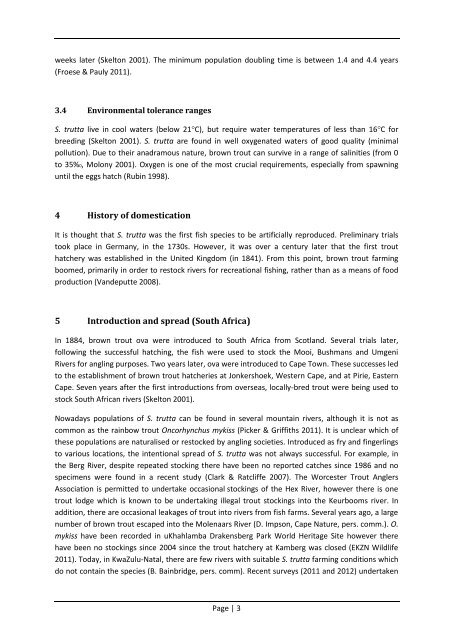Brown trout Salmo trutta - Department of Agriculture, Forestry and ...
Brown trout Salmo trutta - Department of Agriculture, Forestry and ...
Brown trout Salmo trutta - Department of Agriculture, Forestry and ...
You also want an ePaper? Increase the reach of your titles
YUMPU automatically turns print PDFs into web optimized ePapers that Google loves.
weeks later (Skelton 2001). The minimum population doubling time is between 1.4 <strong>and</strong> 4.4 years(Froese & Pauly 2011).3.4 Environmental tolerance rangesS. <strong>trutta</strong> live in cool waters (below 21°C), but require water temperatures <strong>of</strong> less than 16°C forbreeding (Skelton 2001). S. <strong>trutta</strong> are found in well oxygenated waters <strong>of</strong> good quality (minimalpollution). Due to their anadramous nature, brown <strong>trout</strong> can survive in a range <strong>of</strong> salinities (from 0to 35%0, Molony 2001). Oxygen is one <strong>of</strong> the most crucial requirements, especially from spawninguntil the eggs hatch (Rubin 1998).4 History <strong>of</strong> domesticationIt is thought that S. <strong>trutta</strong> was the first fish species to be artificially reproduced. Preliminary trialstook place in Germany, in the 1730s. However, it was over a century later that the first <strong>trout</strong>hatchery was established in the United Kingdom (in 1841). From this point, brown <strong>trout</strong> farmingboomed, primarily in order to restock rivers for recreational fishing, rather than as a means <strong>of</strong> foodproduction (V<strong>and</strong>eputte 2008).5 Introduction <strong>and</strong> spread (South Africa)In 1884, brown <strong>trout</strong> ova were introduced to South Africa from Scotl<strong>and</strong>. Several trials later,following the successful hatching, the fish were used to stock the Mooi, Bushmans <strong>and</strong> UmgeniRivers for angling purposes. Two years later, ova were introduced to Cape Town. These successes ledto the establishment <strong>of</strong> brown <strong>trout</strong> hatcheries at Jonkershoek, Western Cape, <strong>and</strong> at Pirie, EasternCape. Seven years after the first introductions from overseas, locally-bred <strong>trout</strong> were being used tostock South African rivers (Skelton 2001).Nowadays populations <strong>of</strong> S. <strong>trutta</strong> can be found in several mountain rivers, although it is not ascommon as the rainbow <strong>trout</strong> Oncorhynchus mykiss (Picker & Griffiths 2011). It is unclear which <strong>of</strong>these populations are naturalised or restocked by angling societies. Introduced as fry <strong>and</strong> fingerlingsto various locations, the intentional spread <strong>of</strong> S. <strong>trutta</strong> was not always successful. For example, inthe Berg River, despite repeated stocking there have been no reported catches since 1986 <strong>and</strong> nospecimens were found in a recent study (Clark & Ratcliffe 2007). The Worcester Trout AnglersAssociation is permitted to undertake occasional stockings <strong>of</strong> the Hex River, however there is one<strong>trout</strong> lodge which is known to be undertaking illegal <strong>trout</strong> stockings into the Keurbooms river. Inaddition, there are occasional leakages <strong>of</strong> <strong>trout</strong> into rivers from fish farms. Several years ago, a largenumber <strong>of</strong> brown <strong>trout</strong> escaped into the Molenaars River (D. Impson, Cape Nature, pers. comm.). O.mykiss have been recorded in uKhahlamba Drakensberg Park World Heritage Site however therehave been no stockings since 2004 since the <strong>trout</strong> hatchery at Kamberg was closed (EKZN Wildlife2011). Today, in KwaZulu-Natal, there are few rivers with suitable S. <strong>trutta</strong> farming conditions whichdo not contain the species (B. Bainbridge, pers. comm). Recent surveys (2011 <strong>and</strong> 2012) undertakenPage | 3
















